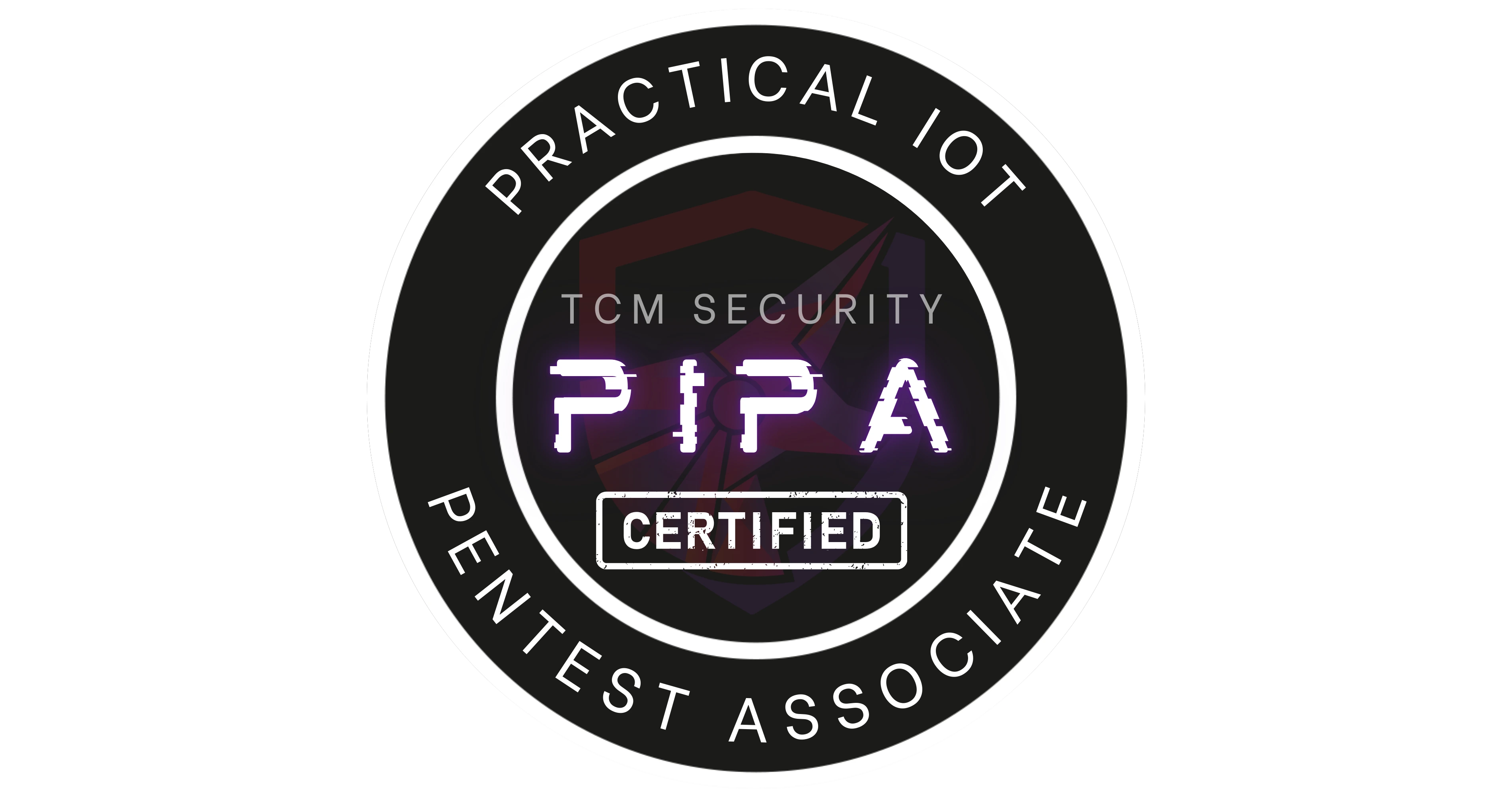Practical IoT Pentest Associate (PIPA) exam
Practical IoT Pentest Associate (PIPA) exam.
The Practical IoT Pentest Associate (PIPA) by TCM is an entry-level certification focused on performing a comprehensive of firmware extracted from a embedded device. The time to assess the firmware is two full days, the time to write a report is an additional two days.
Training: Beginner’s Guide to IoT and Hardware Hacking
To prepare for the exam, TCM offers the Beginner’s Guide to IoT and Hardware Hacking course. This course has all the foundational knowledge and practical skills needed for the exam, including:
- Basics of electrical engineering and electronics
- Identifying common electronic components
- Using essential hardware hacking tools such as:
- Digital multimeters
- Logic analyzers
- USB-to-serial adapters
- Flash programmers
- Optional soldering lessons
- OSINT (Open Source Intelligence) and hardware reconnaissance
- Reading and interpreting datasheets
- Understanding common IoT protocols like UART and SPI
- Initiating and using a serial shell
- Methods for firmware extraction
- Firmware analysis and reverse engineering
 Fig.1 Beginner’s Guide to IoT and Hardware Hacking
Fig.1 Beginner’s Guide to IoT and Hardware Hacking
The course is self-paced and includes 13 hours of video content. However, if you aim to complete all the practical exercises and challenges, expect to spend more.
Personally, I found the training to be well-structured, hands-on, and easy to follow. It explains concepts thoroughly, while encouraging a problem-solving mindset. To focus on areas most relevant to the exam, I repeated the sections on Logic Analyzers, Firmware Analysis, and Reverse Engineering.
Additionally, I have read the “Getting Started with IoT & Hardware Hacking” blog by Andrew Bellini, the course instructor, for extra tips.
The Exam: A Realistic Firmware Review
The PIPA exam is designed to simulate a real-world firmware review with one main challenge: find as many vulnerabilities as possible in the provided materials. There are no flags, questions, or checklists. There is just the 48-hour time limit to dive deep into the analysis.
My Experience
As I started the exam, a little bit nervous, I found the firmware, logic analyzer captures, high level design documents ready to be investigated and the rules of engagement. After making a copy of all the provided samples I following the methodology from the training and I was able to find different vulnerabilities.
Over the full 48 hours, I identified multiple vulnerabilities in the firmware and communication data. The style of the exam was indeed the resemblance of a real test, and although this made me nervous in the beginning, it also was very fun and challenging to focus on every threat and lead without being lead by flags or questions.
Writing the Report
During the exam, I took detailed notes of my findings, thoughts, and leads, and captured plenty of screenshots for reference. These notes proved extremely helpful when writing the report.
With the provided report template, I spent about 24 hours documenting my findings. Interestingly, while reviewing my notes during the report phase, I even found an additional vulnerability that I had initially missed!
The Result
After submitting the report, I received my results within one day, and I’m excited to share that I passed!
Final Thoughts
I thoroughly enjoyed both the training and the exam. The Beginner’s Guide to IoT and Hardware Hacking course offers an excellent introduction to IoT security, providing a solid foundation for those new to hardware hacking.
The exam itself is a perfect follow-up, challenging you to apply what you’ve learned in a realistic, hands-on scenario. TCM Security has done a fantastic job balancing learning with real-world applicability.
I genuinely hope TCM creates a professional-level IoT hacking course in the future to continue building on this knowledge. For now, I can confidently say that the PIPA certification is an excellent starting point for anyone interested in IoT security.

